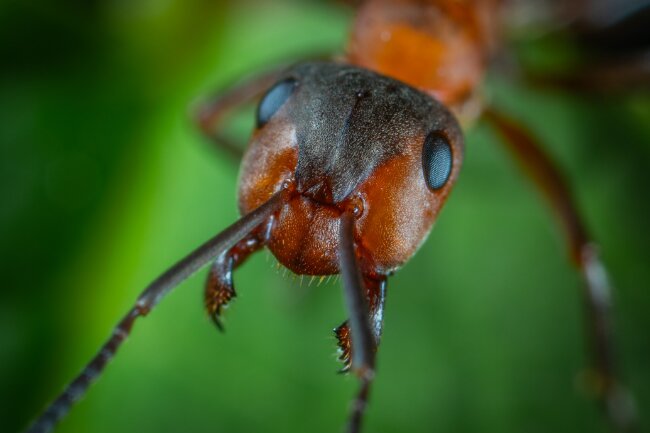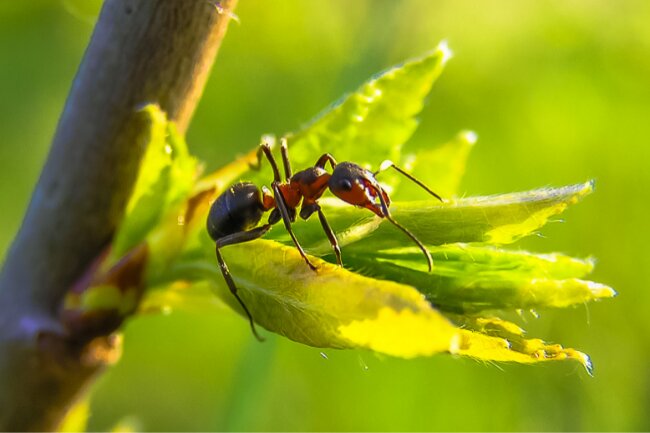Ants use a number of different ways to communicate with one another. The most important sense they have is smell, and they use pheromones to communicate a wide range of things. As well as smell, they use touch, sound and body language.
Contents
| Communication Mode | Description |
|---|---|
| Chemical Communication | Ants release and detect chemical signals called pheromones to communicate various messages |
| Tactile Communication | Physical contact, such as antennal touching or trophallaxis, is used to transmit information |
| Vibrational Communication | Ants use substrate vibrations, generated by movement or specialized signals, to communicate |
| Acoustic Communication | Some ants produce airborne sounds through stridulation or drumming to communicate with others |
Smell

Smell is the most significant sense for ants and is incredibly useful when it comes to communicating. One often-cited example is that ants lay down scent trails for their comrades to follow, leading to and from food or back to the nest.
The scent also helps them to distinguish ants from their own nest from ants from other nests, each nest having its own smell. This is important as ants from other nests are generally considered foes and often attacked, whereas ants from their own nest will be accepted. If an ant from their own nest is injured, they will take them back to the nest to care for them, whereas enemy ants are left to die.
| Pheromone | Function |
|---|---|
| Trail Pheromones | Guide ants along established paths to food sources or new nesting sites |
| Alarm Pheromones | Alert nearby ants to potential threats or danger |
| Recruitment Pheromones | Attract other ants to food sources or specific locations |
| Queen Pheromones | Maintain social order within the colony and regulate reproductive behaviors |
Ants also have a strongly hierarchical society, and an individual’s smell will tell the ant where they sit on the food change. Ants higher up in the nest’s society will be given preferential treatment and prioritised for aid if required.
Ants do not have noses, instead of the main way they ‘smell’ is through their antennae. The antennae have small hair-like sensors that can pick up various chemicals. When these chemicals are detected, electrical signals are sent down to the ant’s brain.
Also read: Answering “Do Ants Bury Their Dead?” (Explained)
Touch

While we may not think of touch as being an essential sense for a species without hands, ants rely heavily on it when investigating objects they are close to. Their antennae are the main appendage they can use for this task, as a special elbow bend in them means the ants can bend them down to touch and feel the object in front of them, this is what’s known as a geniculate antenna.
While touch may largely be through the use of antennae, some species will use their forelegs to perform this task as well. Another interesting addition to touch is the exchange of liquids or foods, known as trophallaxis.
Also read: Wondering if “Millipedes have Antennae?” (Sensory Organ)
Sound
Compared to some insects, ants seem relatively mute to us. We don’t sit out in the evenings listening to the songs of the ants chirruping away, or rasping out a dry tune into the wind. Yet, ants do use sound as one method of communication.
There are several ways an ant can communicate. Stridulation is most known from grasshoppers, who rub raised bumps on their legs across their wing casings to create a range of sounds.
Ants from the Myrmica genus have a raised spike on their abdomen that they rub their legs across. While this doesn’t make the same level of sound as a grasshopper’s musical attempts, it’s enough to get the message to other ants, which is all they require.
Within the same group, it’s been found that even more mature pupa can use this method to produce sound, though in younger pupa their exoskeletons are too soft to allow the process to work.
In some ant species, they have also learnt to drum, using their abdomens to hit the outside of the ant’s nest in order to produce vibrations inside.
Also read: How do Grasshoppers Make Sound? (When & Why)
Body language

Though most ant species don’t have very good eyesight, they can see up close. As well as the all-important pheromones, ants use a range of body language to communicate with one another. While many of these signals are not well recorded, they can be things like raising their abdomens in the air, which could be the equivalent of a human nod.
Communication when they find food
When an individual ant finds food, particularly a large amount of food, their most important task is to bring other ants to the food source so that they can make the most of it. First, the ant will return to the nest, leaving a trail of pheromones, known as a scent trail, for the other ants to follow.
Once at the nest, she may use a mixture of pheromones and body language to communicate to her fellow workers that there’s a tasty treat to be had. She may also regurgitate some of it for the other ant to taste, so they can know exactly how good the prize is, that’s awaiting them.
Communication when they are being attacked

You will often notice that if one ant becomes harmed, other ants appear as if having been called into the scene of the crime. This is exactly what is happening, as ants release special chemicals when they are in distress. These pheromones warn other ants of the danger, so they come to investigate and see if they can help.
Sound is another important way to send out a distress signal. Both stridulation and the warning drumming call in other ants by telling them that the individual or nest is under attack.
Communication when they need to attack something
Ants are highly territorial, and will often attack nearby nests. Many species are also hunters. In order to call others to them when they need help with an enemy or a large prey animal, they can release pheromones to attract other ants to them.
Also read: Here’s “How Ants Become Queens” – FAQ
Liars
In many ways, ants have evolved to be queens of their surroundings. They may be small, but they are perfectly adapted to weave their way through the gaps left by other creatures and come out on top.
However, there are those that have learnt to take advantage of the ant’s way of life. A number of blue butterflies use ant nests are a safe place to rest out the winter as a caterpillar, and later a pupa, before emerging as their beautiful adult selves.
The way they’ve gotten around the ants’ natural instinct to attack is by copying the ants’ language. These species use both distress signals, through mimicking the sounds the ants make and releasing pheromones that trick the ants into thinking a big fat caterpillar is a little ant larva.
Chatty ants
The more we learn about the natural world, the more we realise that there are millions of conversations going on around us all the time. From trees releasing distress signals when they are being eaten by caterpillars, to pupa screaming out to be left alone.
Ants may appear stoically mute to us, but in fact, they are constantly jabbering away, telling their friends who they are, pointing others in the right direction for a tasty treat, and kowtowing to their elders.
It’s a good reminder that just because we can’t hear the words other species speak doesn’t mean they aren’t busy chatting away to one another, just too quiet for us to hear.

